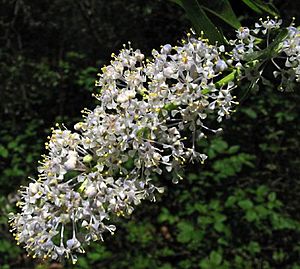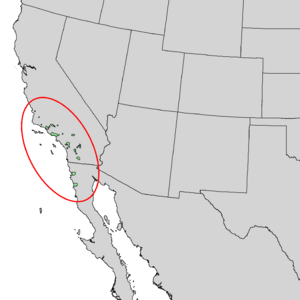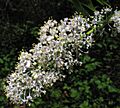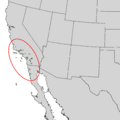Ceanothus spinosus facts for kids
Quick facts for kids Ceanothus spinosus |
|
|---|---|
 |
|
| Scientific classification | |
| Genus: |
Ceanothus
|
| Species: |
spinosus
|
 |
|
| Natural range of Ceanothus spinosus in California chaparral and woodlands habitats. | |
Ceanothus spinosus, also known as greenbark or redheart, is a type of plant in the Ceanothus family. It grows naturally in southern California and northern Baja California. You can find it in the scrublands and chaparral areas of the coastal mountains.
Contents
What is Ceanothus spinosus?
This plant is a large shrub that can grow almost like a small tree. It can reach up to 6 meters (about 20 feet) in height. It's known for its unique green bark and spiny branches.
Where Does It Grow?
Ceanothus spinosus is found in the sunny, dry areas of southern California and northern Baja California. It thrives in the chaparral and scrub habitats. These are places with many shrubs and small trees that are good at surviving dry weather.
Leaves and Stems
The leaves of this plant are thick and stay green all year round. They are oval-shaped, about an inch wide, and have smooth edges. Each leaf has one main line (vein) that starts from its base.
The bark on the branches is smooth and olive green. This is why one of its common names is "greenbark." Near the ground, the main stem (trunk) has rougher bark. The branches are stiff and have sharp, spiny tips. The name Ceanothus actually means "spiny plant" in Greek. The species name, spinosus, means it is even more spiny! Small, leaf-like parts called stipules grow at the base of the leaf stems, but they are thin and fall off quickly.
Flowers and Fruit
This shrub produces beautiful clusters of white to light blue flowers. These flower clusters can be up to 15 centimeters (about 6 inches) long. The plant blooms from February to May, bringing a splash of color to its habitat.
After the flowers, small, smooth, round fruits appear. Each fruit is about half a centimeter wide and has three sections. Unlike some other plants in the Ceanothus family, these fruits do not have horn-like shapes.
Images for kids



